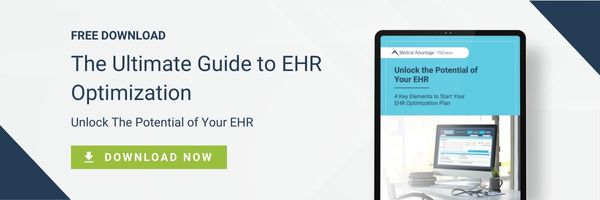What Is EHR Optimization?
Creating EHR Optimization Strategy: Step by Step
Step 1: Preliminary Research
Step 2: Gather Pain Points from All Users
Step 3: Evaluate Technology and People
Step 4: Assemble a Task Force
Step 5: Make Adjustments
Step 6: Keep Going
Summary: What is EHR Optimization?
Get a Thorough EHR Optimization from a Medical Advantage Consultant
An electronic health record (EHR) should be a vehicle for providing quality care, but many healthcare professionals find the EHR to be a hindrance more than a help. In fact, it has been confirmed that EHRs contribute to burnout in the medical field. Rather than change EHRs (which is costly) you can optimize instead.
What is EHR optimization? EHR optimization techniques are essentially the process of finding and applying solutions to your EHR problems, layer by layer. It spurs from the realization that you may never reach your care quality and business goals if these issues are never addressed.
EHR Optimization Definition
EHR optimization “requires a tailored, multipronged strategy that incorporates an organization’s clinician-identified pain points, clinical informatics and technology resources, and clinician and leadership buy-in.” National Academy of Medicine.
At its best, an EHR system should help maximize revenue, make healthcare more efficient so that it delivers better patient outcomes, streamline workflows, and provide quick and easy access to medical records by patient and provider alike.
EHR optimization is gathering all the problems with your EHR and finding solutions, one issue at a time. With the help of an EHR expert consultant, you can uncover many more improvement opportunities you may not have thought of before.
What Are the Benefits of EHR Optimization in Healthcare?
EHR importance cannot be overstated. This technology has completely transformed the medical industry in recent years, making it more efficient and systematic. However, to get the most out of EHRs, organizations must optimize them according to their individual needs. Benefits of EHR optimization include:
- Improved Efficiency: EHR optimization can lead to improved clinical efficiency by reducing the time required for manual charting and documentation. With optimized EHRs, physicians and medical staff can easily access patient records, streamline workflows, and enhance communication during consultations, resulting in improved efficiency, productivity, and patient outcomes.
- Cost Savings: EHR optimization can significantly reduce indirect costs by minimizing paperwork, improving billing processes, and reducing medication errors. Since EHRs also enable medical professionals to access vital information in real-time, it can avoid redundancy of lab tests and doctor’s appointments, ensuring that medical professionals are not confined by geographical or time barriers.
- Accessible Data: EHR optimization enhances the accessibility of medical data across multiple locations and different healthcare providers. Medical professionals can easily access patient records, charts, test results, and other crucial medical information on a single platform. This level of accessibility ensures that medical professionals can provide quality patient care, regardless of location, while making it easier for organizations to handle patient records securely.
- Enhanced Patient Safety: EHR optimization can improve patient safety by reducing medical errors and improving medication management systems. By providing easy and quick access to patient records, physicians get a complete picture of patients’ medical history to make more informed decisions. Optimized EHRs can also alert physicians of potential drug interactions, allergies, and other important alerts.
- More Effective Reporting: EHR optimization also makes more effective reporting possible. Optimized EHRs can help generate reports, identify trends, and generate defensible data that can be used in quality improvement initiatives, research, and public health-oriented projects.
Barriers to EHR Optimization
Implementing and optimizing EHRs is not without its challenges, and healthcare professionals need to be aware of potential barriers to their success. The following are some of the common barriers to EHR optimization.
EHR Optimization Cost and Implementation
One of the primary barriers to implementing and optimizing EHRs is the financial burden that comes with it. The cost of implementing EHRs can be a significant investment for healthcare facilities, and this cost may discourage some organizations from adopting these tools. Moreover, when EHR implementation isn’t done correctly, it can lead to long-term financial consequences in the form of missed revenue opportunities, lower productivity, increased expenses, and higher employee turnover. To overcome this barrier, healthcare facilities can build comprehensive business models that take into account the long-term financial benefits of EHR adoption. In addition, seeking grants, subsidies, and tax benefits from government and other agencies can also help.
Limited Technical Expertise
Another common challenge healthcare providers face when trying to optimize EHRs is a lack of technical expertise. Healthcare professionals are not typically trained in the technical aspects of EHR applications, and it’s not uncommon for organizations to rely on vendor support to troubleshoot issues with these systems. Healthcare facilities can overcome this barrier by upskilling their technical staff or seeking training programs that can equip healthcare providers with the skills they need to optimize EHRs.
Interoperability and Data Exchange Issues
A lack of interoperability and data exchange between different EHR systems can also be a barrier to EHR optimization. When data is not easily accessible to different healthcare providers or organizations, it can result in duplication of data entry, missed diagnoses, and incorrect treatment. Healthcare providers can overcome this challenge by encouraging patients to participate in health information exchanges or by investing in infrastructure that promotes interoperability and data exchange.
Resistance to Change
Healthcare providers can also face resistance to EHR optimization from their team members or patients. Resistance to change can arise due to a lack of awareness of the benefits of EHRs, perceived loss of control over traditional clinical workflows, or fear of technology replacing human interactions. Healthcare providers can overcome this challenge by creating a culture of collaboration and open communication, involving team members in the EHR optimization process, and seeking feedback from patients on their experiences.
Creating EHR Optimization Strategy: Step by Step
What is EHR optimization strategy? One might say that optimization strategy unfolds once you understand EHR importance and the benefits that come from demanding more of your EHR and that it is worth the costs of pursuing.
EHR optimization techniques include assessments that look at many aspects of your organization. The steps provided are intended to serve as a basic template. As you draft your plans, keep in mind that the needs of your healthcare organization are not likely to match the one around the corner, so your strategy should be tailored to the unique needs of your organization.
Step 1: Preliminary Research
While there are many sources to gather information about EHR optimization, remember to talk to peers in your field from other organizations. It would be especially helpful to talk to those who use the same EHR software as yours.
This is also a time to investigate the fiscal impact of your EHR. Are you having problems with reimbursements, missing out on incentives, or experiencing significant turnover? Solutions such as EHR data optimization can correct your revenue cycle management and be a return on investment for your optimization efforts.
Step 2: Gather Pain Points from All Users
What is EHR optimization from each perspective of your organization? Gather feedback from all users of your EHR regarding their individual experiences with functionality. This could be done by survey, email, meetings, etc. Depending on what improvements you hope to make, you may need to gather feedback from patients as well.
Shadow your providers, nurses, medical assistants, business office staff, and any patient-facing roles of your operation. Enter the clinic from the patient’s perspective and follow the course they take during a typical visit. Observe how your staff members use the EHR as they interact with patients. Things to consider when mapping patient journey:
- Are there areas of their check-in, rooming, visit, or check out that could be improved when it comes to their interaction with your staff and the EHR?
- Are you doing things to reduce check-in times, like using a check-in kiosk?
- Are patients able to fill out paperwork ahead of time in their patient portal?
- Does the portal consistently provide what the patients need to stay on track with their care plan?
Once you have identified those areas that cause the most stress and frustration for your patients and staff, you can begin to implement changes by working on the low-hanging fruit – items that are relatively easy to implement but will have a significant impact.
Anything that can be done to streamline workflows and make documentation more efficient will bring you closer to optimization success.
Step 3: Evaluate Technology and People
To improve the relationship between the EHR and its users, we assess each individually.
Run a complete diagnostic on your software, equipment, and internet connectivity to see if there are technical issues that interfere with your EHR experience. Check for issues with:
- Old, outdated hardware
- Slow local internet (LAN)
- Slow speeds with the internet service provider (ISP)
- Wi-Fi not properly configured or dropped connection from a spotty signal
- Latency issues with the software, or add-on modules
- Overwhelmed data center
What about the people using your EHR? For an optimal EHR experience, the training of those using the EHR should be fine-tuned alongside calibrating the EHR.
How well do your staff members understand how to use the EHR, or even computers for that matter? You may find that some need remedial training in technology usage. As employees come and go, it is quite possible that important training information was lost along the way.
“With the right EHR training, you can establish best practices that will support your organization’s long-term goals and maximize functional capability so that each team member can do their best work. Naturally, this will lead to increased work satisfaction and improved patient care.” – Maximize Practice Performance Through EHR Optimization,
Medical Advantage
By that same token, you should evaluate if your current standards and policies are being followed. If conformance appears to be on the level, it may be time to update the standards to elevate team performance.
This would also be an opportune time to evaluate your data governance policies, especially in terms of interoperability standards.
Step 4: Assemble a Task Force
Optimizing your EHR is a team effort. Who would be the best staff members to bring into developing an EHR optimization strategy? Some of the most common additions to an EHR committee are:
- Ambassadors: One person from each department to speak for the group. Be sure to include someone from the information technology (IT) team if you have one.
- Superuser: A superuser is one person who is tasked with being more extensively trained on the EHR than the rest of the organization. Oftentimes this role is given to someone who has the most diverse or the longest experience with EHRs.
- Practice Manager: This managerial role ensures patient care continues while some staff are in training. You may choose to hire temporary staff or call upon PRN staff to fill in as needed.
- Physician champion: Like your super user, the physician champion will have substantial EHR experience. Ideally, this role should be filled by someone who is well respected by the staff, is effective in keeping things positive during major changes, and can coach staff members on usage techniques. This role is crucial for garnering much needed staff buy-in.
Step 5: Personalize the User Experience for Each Individual Role
What changes can be made for each user that will make them perform more efficiently? Your optimization team can help you identify and address these opportunities individually. Healthcare workers tend to get “alarm fatigue” from EHRs when the same unnecessary alerts keep interrupting tasks.
Ideally, the template and interface should be tailored to the role of the user. For example, it does not make sense to have the same interface settings for the front desk that you would for the clinician. What can be changed to improve the EHR user experience for each individual role?
Step 6: Keep Going
Major optimizations, implementation, and the initial go-live are all big events where there is intense focus on the EHR. Even with those events behind you, there is still a need to continue improving. As to what is EHR optimization long term, here are some ideas:
- Continue gathering feedback from staff and patients
- Keep up with the latest trends in EHR such as artificial intelligence (AI), machine learning (ML) and robotic process automation (RPA)
- Reach out to support solutions such as the Medical Advantage helpdesk
Summary: EHR Optimization Definition
All too often, healthcare professionals find that an EHR causes more work, headaches, or it does not perform as they expected it to. However, EHR importance cannot be overstated. The cost-effective alternative to replacing an EHR is optimization.
What is EHR optimization? EHR optimization is the process of identifying all the improvement opportunities and finding solutions to resolve each pain point or flaw, one by one.
Your EHR strategy includes gathering feedback from all users of the EHR, assessing the skill level of your staff members individually, looking for unresolved technical issues, assembling a task force, making fixes as you go, and gathering more feedback along the way.
Some opportunities are not easily spotted, and some solutions require expertise to carry out. To get the most from your EHR, enlist an experienced EHR consultant to help you make your EHR work better than you thought possible.
Get a Thorough EHR Optimization from a Medical Advantage Consultant
Is your EHR holding you back from achieving your organization’s goals? This happens more than you might think. At Medical Advantage, our goal is to make your EHR a vehicle for success rather than a deadweight holding you back.
We focus on efficiency, best practices in interoperability, patient engagement, and maximizing revenue. Take the first step toward optimizing your EHR by filling out the form below!





